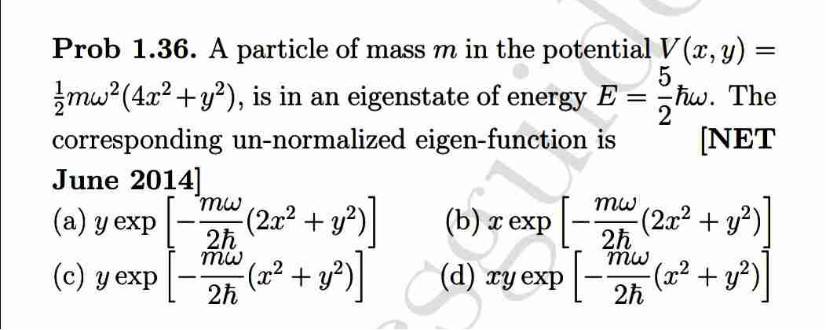
ToHide:
Observation
This a system of two oscillators?
Thinking
What are the frequencies? What does the expression for potential energy tell us?
Hint
YES.
From the potentail energy we see that the x frequency is 2\(\omega\) and \(y\) frequency is \(\omega\);
The frequencies are different.
OBSERVATION
Look at the factor inside the exponential.
How can we use this information ?
Question
What does this tell about the frequencies? Is any option ruled out?
Hint
\(\omega_1=2, \omega_2=1\) is correct for expressions inside the exponential for options (a) and (b);
For options (c) and (d) the exponential expression corresponds to equal frequencies;
hence (c) and (d) are ruled out.
We are left with options (a) and (b).
OBSERVATION
The energy is given to be \(E=\frac{5}{2} \hbar \omega\).
What will be the energy for \(n_1, n_2\) state? The energy levels for a single oscillator are \(E_n=\frac{1}{2}\hbar \omega(n+1/2)\); So \(E=\hbar \omega [2(n_1 +1/2) + (n_2+1/2)] =\frac{1}{2}\hbar \omega [(2n_1 + n_2 + 3/2)]\)QUESTION
ANSWER
Let Us Think
So what combinations of \(n_1, n_2\) are allowed and which ones are ruled out?
Take different values
\(n_1=0,1,2...\qquad n_=0,1,2,...\)
and see what is possible.
ANSWER
The first possibility is \(n_1=1 \) and \(n_2=0\)
The second possibility \(n_1=0 \) and \(n_2=1\)
QUESTIONS --- Thinking
I think \(n_1=1 \) and \(n_2=0\) is already ruled out by the given energy value.
What part of the wave function depends on the \(n_1,n_2\)? How else are the wave functions different?
OBSERVATION
Look at the factor outside the exponential.
Can you use this information to decide between the two option we are left with?
The factor \(x\) means the first excited state \(n_1=1\). And \(y\) means \(n_2=1\) first excited state of \(y\) oscillator.
Option (a) means \(n_1= 0, n_2=1\) This gives \(E=5/2 \hbar \omega\)
Option (b) means \(n_1=1, n_2=0\) This gives \(E=7/2 \hbar \omega\); ruled out by total energy value.
So option (a) is the correct option.
Exclude node summary :
Now summarize what all results you needed to solve this problem.






 ||Message]
||Message]

Comments
to be reviewed
to be reviewed